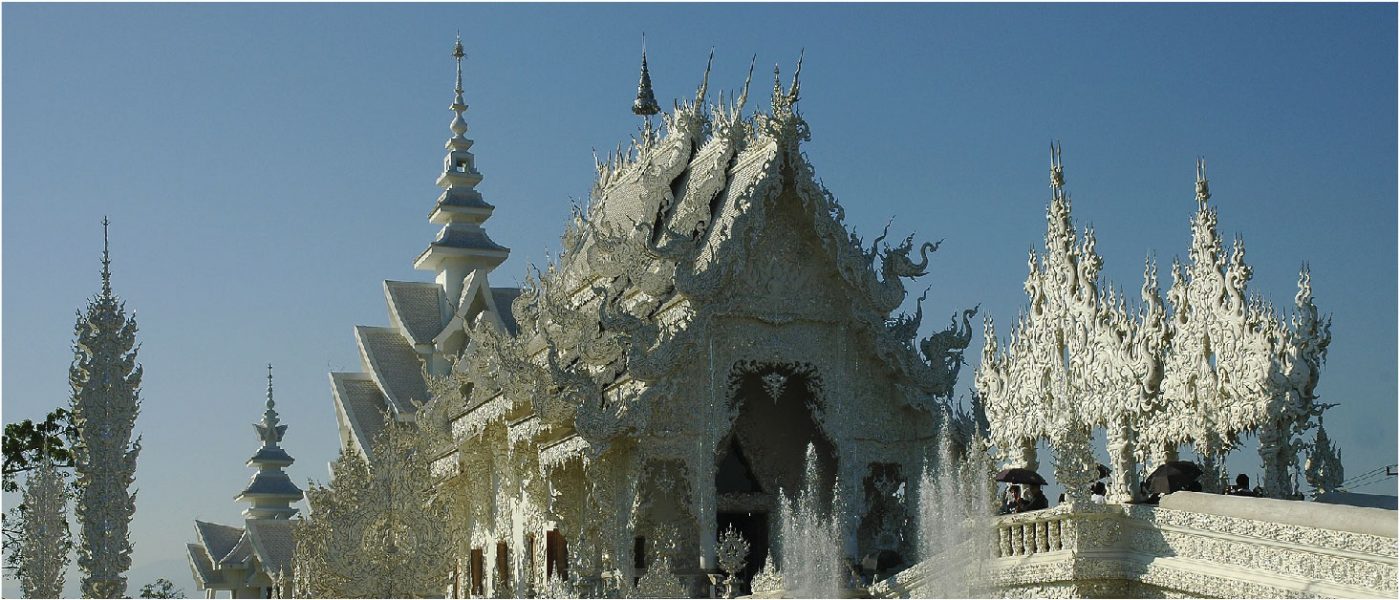
I am neither religious nor especially spiritual nor convinced that God exists. Jewish by background, I am secular in practice. And while I appreciate the architecture of many houses of worship—churches, cathedrals, synagogues, mosques—visiting a few on any given vacation is sufficient for me. So on day six of our Thailand trip, when our tour guide suggested we stop to see yet another Buddhist temple on our way out of Chiang Rai, I was not excited. Wat Rong Khun was not on our itinerary and we’d already spent copious hours viewing, touring, climbing, and photographing temples. “You have to see this one,” she insisted. “It’s different.”
My partner Arnie, our travel buddies Jeanne and Richard, and I settled into our tour van and we rode thirteen kilometers to the structure better known as The White Temple. Our driver parked and we got out and entered the grounds. Thai and foreign tourists milled about. Saffron-robed monks dotted the area. And there it was! The White Temple rose like a giant wedding cake iced with creamy curlicues, glittering like a glacier, a blinged-out fairyland castle framed by filigreed pillars and reflected in pools of water. A curious comingling of the ancient and the modern.
I was awed and enraptured at first glance.
The creation of millionaire Chiang Rai-born artist Charlermchai Kositpipat and funded completely by him, The White Temple, which opened in 1999, is fashioned from white plaster and countless tiny, mirrored mosaic chips. The whiteness represents the purity of Buddha, the mirrored glass, Buddha’s enlightenment.
But the temple surroundings hold surprises in sharp contrast to the beauty and majesty of the temple itself.
As we strolled toward the wat,we encountered ghoulish sculptures and unholy creatures or parts of them: a tentacled alien emerged from the lawn; twisted demons flashed pointed teeth; red skeletal hands brandished packs of Marlboros; a fiery skull balanced a whisky bottle; disembodied heads, some pig-faced or their eyes dangling from sockets, hung from tree branches and sprouted strings of moss. I am drawn to the macabre,the strange, the weird, so I was charmed and tickled by this juxtaposition of the sublime and the bizarre, the divine and the degenerate, the grand and the grisly, the artist’s tongue-in-cheek way of informing us smoking and drinking were not permitted at the site. He has a wicked sense of humor, I thought. I later learned Kositpipat’s intent was to warn about the dangers of cigarettes and alcohol and to encourage us to rise above our cravings.
We approached a bridge called The Cycle of Rebirth which symbolically separated a hell below us from Heaven—the actual temple—on the other side. As we crossed, hundreds of clay hands reached up from the depths as if trying to drag us down. For Kositpipat this scene represented the need to overcome temptation, greed, and desire before one can reach nirvana.The symbolism was lost on me. I was simply enchanted by the gruesome sea of the condemned. It reminded me of the fun houses of my childhood.
Sword-flashing Thai warrior statues guarded the temple. We climbed its steps, removed our shoes, and entered. At the end of a crimson carpet, two beatific Buddhas, one gold, one white, sat in the lotus position, one above the other. Typical temple statues. But the walls were painted with murals like no other in a Buddhist shrine. Kositpipat combined traditional Thai images with contemporary characters and scenes. A giant Buddha, a Thai boat, and lotus flowers share space with comic book and film heroes and villains—Batman, Superman, Spiderman, Harry Potter, The Terminator,Freddie Krueger from “A Nightmare on Elm Street.” I spotted Michael Jackson, Hello Kitty, Osama bin Laden. I saw a volcano erupting, alien spacecraft flying, planes crashing into the Twin Towers. The images morphed and swirled in a flaming orange surreal spectacle; The Dalai Llama melded with Salvatore Dali, the past vs. pop culture, the struggle between the forces of good and evil. Unexpected. Thrilling. Magical.
I could have spent another hour gazing at the murals, another two exploring the temple compound, but my companions were anxious to return to our van and head to Chiang Mai, our next destination. I walked back over the Cycle of Rebirth bridge then turned for one final look at Wat Rong Khun. It sparkled.
The White Temple did not inspire me to purge my soul. I did not feel the presence of a supernatural being there. I found humor in the work even if the artist did not intend it. If there is a God, I like to think he too has a sense of humor. The White Temple is my most vivid memory of Thailand. And no other house of any God has instilled in me so much wonder and joy. Perhaps, for this nonbeliever, that qualifies as a religious experience.
T
Temple of Irreverence

CategoriesCulture




